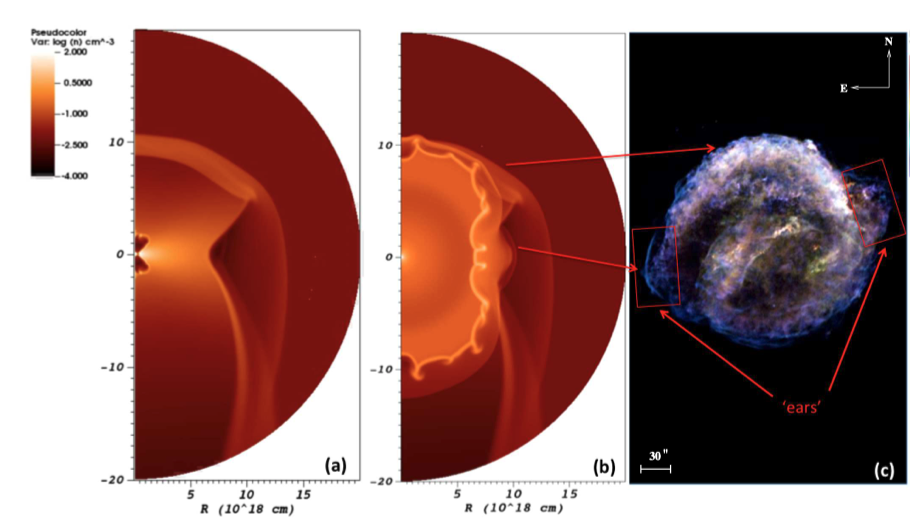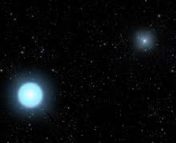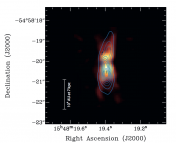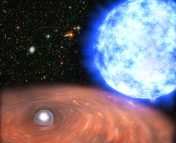Paper Title: The Interaction of Type Ia Supernovae with Planetary Nebulae: the Case of Kepler’s Supernova Remnant
Authors: A. Chiotellis, P. Boumis, and Z. T. Spetsieri
First Author’s Institution: Institute for Astronomy, Astrophysics, Space Applications, and Remote Sensing, National Observatory of Athens, 15236 Penteli, Athens, Greece
Status: Published in MDPI; Open access on arXiv
Volatile Universe
Impermanence. The indelible signature of the Universe.
Transient events, such as energetic stellar explosions and chaotic mergers expose the variable essence of the cosmos. Observed from afar, these stunning events splatter polychromatic ink haphazardly across the cosmic canvas. Despite their violent nature, though, these events enrich the voids of space with the precious ingredients necessary to birth new stars.
While each newborn star’s evolutionary path is unique (see the H-R Diagram), the initial condition that triggers their eventual demise is uniform – hydrogen fusion within their cores becomes exhausted. For stars lighter than 8 solar masses, these cores become helium dominated and begin to contract. As temperatures rise and contraction ensues, carbon and oxygen overtake the region. Hydrogen and helium shells then form around the star’s center, and the temperature gradient between the two induces the propagation of thermal pulses. Consequently, the star’s outer layers are expelled in the turbulent process.
In a dazzling turn of events, the core continues to contract until electron degeneracy pressure commences and produces a dense white dwarf, which ionizes the expelled stellar matter and the local circumstellar medium (CSM). The resulting entity is deemed a planetary nebula.
Critical Mass
In many cases, this is only an intermediary act within a much grander event!
If accompanied by a companion, often a red giant Asymptotic Giant Branch star, a white dwarf can begin to siphon matter from its neighbor. If it accumulates sufficient mass and exceeds the Chandrasekhar limit (1.44 solar masses), electron degeneracy pressure falters in its nail-biting duel with gravity, and the star’s belly ruptures in a dramatic Type Ia supernova (SN Ia) event. During the stellar fireworks, brilliant shock waves are ejected into the depths of space and can approach ~6% the speed of light. The ejected material, and the interstellar material swept by it, form a supernova remnant (SNR).
Expanding Remnant
While SNe Ia have been extensively studied, the properties of the companion star, the accretion dynamics of the progenitor system, and the features of the ultimate explosion remain inconclusive. To address this, the authors of today’s paper analyze the morphology of Type Ia supernova remnants (SNR Ia) and their impact on the CSM to better understand these events.
They focus their attention on the renowned Kepler’s Supernova (SN 1604) remnant and its impact on the CSM.
Existing models of this remnant suggest that an AGB star survived the SN Ia event and is now casting winds that are strongly interacting with the CSM in the remnant’s northern region and is producing side lobes (termed “ears”). However, no observational evidence has confirmed the presence of an AGB in the center of Kepler’s SNR.
Hydrodynamics to the Rescue
Using the hydrodynamic code AMRVAC, the authors explore the idea that a fraction of SNe Ia occur in, and primarily interact with, planetary nebulae (rather than an AGB star) in the progenitor system. In their models, they consider the time delay between the formation of planetary nebulae (i.e. the white dwarf ionizing the CSM) and the eventual SN Ia detonation.
Figure 1 showcases three varying simulations that the team executed: a) SN Ia occurring simultaneously with the formation of a companion white dwarf (time delay of zero), b) with a time delay of 2 million years (Myr), and c) with a time delay of 8 Myr.
(Figure 1 in the paper.)
Model a) showcases a SN Ia event that features a bipolar planetary nebula in the progenitor system. There is no time delay between the SN Ia and the formation of the companion white dwarf in this simulation. The results reveal that an inner cavity forms and is encompassed by a dense halo of the nebula. Model b) presents results after a 2 Myr time delay. Here, the high radial momentum of the model’s fast winds causes the CSM to expand and form a low-density cavity of ~7kpc around the progenitor system. Finally, model c) displays the CSM transitioning from a pressure-driven to momentum-driven mode that forces the CSM to collapse under the pressure of the surrounding medium, leading to a more homogeneous system.
The results from the simulations are effective at producing some of the morphological features observed with Kepler’s SNR Ia. However, to optimize their results, the researchers subsequently input the observed systemic motion, as well as the estimated ejecta energy, mass, and velocity of the remnant into the model.
The revised models show that shocks are able to penetrate the lower density ambient regions in the simulations and reproduce the “ears”! The fascinating similarities between the models and an X-ray observation of the remnant are shown in Figure 2.

One Step Closer
The results from today’s paper are intriguing. The authors have provided strong preliminary evidence that a planetary nebula occupies Kepler’s SN Ia progenitor system, rather than an AGB star. Their ability to reproduce the morphology of the remnant and its surrounding CSM suggest that an alternative mechanism may be necessary to explain the dynamics of SNe Ia.
Ultimately, the authors offer valuable insight into the role of planetary nebulae in the evolution of SN Ia.
Perspective
As we inch closer towards unraveling the properties of stellar evolution today, the Universe tirelessly churns. We fervently seek to elucidate its dynamical spirit. All the while, in the midst of our pursuit to comprehend its mysteries, cataclysmic annihilation and majestic creation remain its signature. As we peer deeper, the hues will continue to grow more radiant as they sprawl further along the cosmic canvas.




